
How to Conduct a Comprehensive SEO Audit in 2024: A Step-by-Step Guide
In the rapidly evolving digital landscape, staying ahead of the competition and ensuring your website ranks high on search engine results pages (SERPs) is more critical than ever. As we step into 2024, the importance of a robust SEO strategy cannot be overstated. Whether you’re a seasoned marketer or a business owner looking to enhance your online presence, understanding how to conduct a comprehensive SEO audit in 2024 is essential to your success. This step-by-step guide will walk you through the latest techniques and tools to optimize your website, improve user experience, and ultimately drive more organic traffic. By following these strategies, you’ll be well-equipped to navigate the complexities of modern SEO and achieve sustainable growth in the digital realm.
**Keyword Research and Analysis: The Foundation of Effective SEO**
Keyword research and analysis are the cornerstones of an effective SEO strategy. Start by identifying the most relevant keywords for your business through tools like Google Keyword Planner, Ahrefs, or SEMrush. These tools help you discover what potential customers are searching for in your niche. Focus on long-tail keywords—phrases that are more specific and usually longer—as they often have less competition and attract more qualified traffic. For instance, instead of targeting “shoes,” you might target “best running shoes for flat feet.”
Once you have a list of potential keywords, analyze their search volume, competition, and relevance to your content. High search volume means more potential traffic, but high competition might make it harder to rank. Strive for a balance by targeting keywords with moderate search volume and low to medium competition. Integrate these keywords naturally into your content, meta descriptions, headers, and URLs to improve your chances of ranking higher on search engine results pages (SERPs).
Don’t forget to regularly revisit and update your keyword strategy. Trends change, and so do search behaviors. Use analytics tools to track which keywords are driving traffic and conversions to your site. Continuous keyword research ensures that your content remains relevant and competitive, keeping your SEO strategy robust and effective in 2024 and beyond.
On-page SEO factors are critical elements that you can control directly on your website to improve its search engine ranking. These factors include optimizing your content, HTML source code, and user experience. Start by ensuring your content is high-quality, relevant, and keyword-optimized. Use tools like Google Keyword Planner to identify the right keywords and naturally incorporate them into your headings, subheadings, and body text. Don’t forget to include meta descriptions and title tags that accurately describe your content and attract clicks.
Another essential on-page SEO factor is the structure of your URLs. Make them clean, concise, and keyword-rich. For example, instead of using a URL like “www.example.com/page1?id=1234,” use “www.example.com/seo-tips-2024.” Additionally, pay attention to internal linking. This helps search engines understand the structure of your site and discover new content. Linking related articles together not only improves SEO but also enhances user experience by keeping visitors engaged longer.
Lastly, focus on the technical aspects such as site speed and mobile-friendliness. A fast-loading website improves user satisfaction and reduces bounce rates. Use tools like Google PageSpeed Insights to assess and optimize your site’s speed. Moreover, with the increasing number of mobile users, ensuring your website is mobile-friendly is non-negotiable. Use responsive design techniques to make sure your site looks great and functions well on all devices. By addressing these on-page SEO factors, you’ll be well on your way to boosting your search engine rankings in 2024.
A Technical SEO Audit is a crucial step in enhancing your website’s performance and search engine ranking. It involves analyzing various technical aspects of your site to ensure it is easily crawlable and indexable by search engines like Google. Start by checking your website’s loading speed using tools like Google PageSpeed Insights. A fast-loading site not only provides a better user experience but also ranks higher in search results. Next, ensure your site has a mobile-friendly design since a significant portion of web traffic comes from mobile devices.
Another key component is to review your website’s URL structure and internal linking. Clean, descriptive URLs and a well-organized internal linking system help search engines understand the content and hierarchy of your site. Don’t forget to check for broken links and fix any 404 errors, as these can negatively impact both user experience and SEO performance. Lastly, make sure your XML sitemap is updated and submitted to search engines, and that your site uses HTTPS to provide secure connections for users. By addressing these technical aspects, you lay a solid foundation for improved search engine visibility and user engagement.
**Content Quality and Optimization**
Ensuring top-notch content quality and optimization is paramount for successful SEO in 2024. Start by evaluating the relevance and value of your content. Each piece should address user intent, providing clear, comprehensive answers to the questions your audience is asking. Use tools like Google Analytics and Search Console to identify high-performing pages and pinpoint areas needing improvement. High-quality content is not just about text; integrate multimedia elements like images, videos, and infographics to enrich user experience and keep visitors engaged.
Next, focus on on-page optimization. This involves making sure that your target keywords are naturally incorporated into your content without keyword stuffing. Keywords should appear in strategic places such as titles, headings, meta descriptions, and throughout the body text. Additionally, use internal linking to connect related content within your site, which helps search engines understand the structure of your site and keeps users on your page longer. Regularly update older content to keep it fresh and relevant; outdated information can harm your credibility and rankings.
Finally, leverage structured data or schema markup to help search engines better understand your content’s context. This can enhance your chances of appearing in rich snippets, which are highly visible search results that can boost click-through rates. By focusing on these aspects of content quality and optimization, you ensure that your website not only ranks well but also provides exceptional value to your audience, aligning perfectly with SEO best practices for 2024.
**Mobile Usability and Performance**
In 2024, optimizing for mobile usability and performance is more crucial than ever. With an increasing number of users accessing websites via smartphones and tablets, your site must deliver a seamless mobile experience. Start by ensuring your website is fully responsive, meaning it adapts fluidly to different screen sizes. Use tools like Google’s Mobile-Friendly Test to identify any issues that could hinder mobile usability, such as text that’s too small to read or elements that are too close together.
Performance on mobile devices is equally important. Slow-loading pages can frustrate users and lead to higher bounce rates. Optimize images by compressing them without losing quality and leverage browser caching to speed up load times. Tools like Google PageSpeed Insights can help you pinpoint performance bottlenecks and suggest improvements. Remember, a fast, user-friendly mobile experience not only pleases visitors but also positively impacts your search engine rankings. Prioritizing mobile usability and performance ensures that your site remains competitive in an increasingly mobile-first world.
Backlink Profile Evaluation is a crucial aspect of SEO that involves analyzing the quality and quantity of external links pointing to your website. High-quality backlinks from reputable sites can significantly boost your site’s authority and search engine ranking. To start, use tools like Ahrefs, Moz, or SEMrush to gather data on your backlinks. Look for metrics such as Domain Authority (DA), Page Authority (PA), and the relevance of the linking sites to your niche. Focus on acquiring backlinks from high-DA sites that are contextually relevant to your content.
Next, identify any toxic or spammy backlinks that could harm your SEO efforts. These are links from low-quality or irrelevant sites that might trigger penalties from search engines like Google. Tools like Google Search Console can help you pinpoint these harmful links. Once identified, you can disavow them using Google’s Disavow Tool to ensure they don’t negatively impact your site’s ranking.
Lastly, monitor your backlink profile regularly to maintain a healthy link ecosystem. Consistently earning high-quality backlinks requires ongoing efforts such as guest blogging, creating shareable content, and building relationships with industry influencers. By maintaining a robust and clean backlink profile, you can enhance your website’s credibility, improve its search engine rankings, and drive more organic traffic.
User Experience and Site Navigation are crucial elements in conducting a comprehensive SEO audit in 2024. A positive user experience ensures that visitors stay longer on your site, engage with your content, and are more likely to convert into customers. To optimize for user experience, ensure your website loads quickly, is mobile-friendly, and has a clean, intuitive design. Slow load times and clunky interfaces can frustrate users and lead to higher bounce rates, negatively impacting your SEO rankings.
Effective site navigation plays a pivotal role in enhancing user experience and boosting SEO performance. A well-structured navigation system makes it easy for users to find the information they need, reducing frustration and increasing time spent on your site. Use clear, descriptive labels for your menu items and organize them logically. Implement internal linking strategies to guide users through related content seamlessly. This not only helps users but also enables search engines to crawl your site more efficiently, improving your chances of ranking higher in search results.
In summary, focusing on user experience and site navigation is essential for a successful SEO strategy in 2024. By ensuring fast load times, mobile optimization, clean design, and intuitive navigation, you can enhance user satisfaction and improve your search engine rankings. Remember, a happy user is more likely to become a return visitor or customer, ultimately driving the success of your online presence.
Local SEO is crucial for businesses aiming to attract customers within a specific geographic area. To optimize your local SEO, start by claiming and optimizing your Google My Business (GMB) listing. Ensure that all details such as your business name, address, phone number, and hours of operation are accurate. Adding high-quality images and encouraging satisfied customers to leave reviews can significantly enhance your local search visibility.
Next, focus on local citations by ensuring your business information is consistent across various online directories like Yelp, Bing Places, and local business chambers. Consistency helps search engines verify the legitimacy of your business, improving your ranking in local searches. Additionally, incorporate local keywords into your website content, meta descriptions, and headers. For instance, if you run a bakery in Austin, phrases like “best bakery in Austin” can help attract nearby customers searching for baked goods.
Lastly, create localized content that resonates with your community. This could be blog posts about local events, collaborations with nearby businesses, or highlighting customer stories from your area. Engaging with the local community not only builds trust but also boosts your relevance in local search results. By focusing on these key areas—GMB optimization, local citations, and localized content—you can significantly improve your local SEO performance and attract more customers from your target area.
Competitor Analysis is a crucial component of any comprehensive SEO audit in 2024. By examining the strategies and performance of your top competitors, you can uncover valuable insights that help you refine your own SEO tactics. Start by identifying your main competitors using tools like SEMrush or Ahrefs, focusing on those who rank highly for your target keywords. Analyze their website structure, content quality, backlink profile, and keyword usage to identify what they are doing right and where they might be lacking.
Next, compare their strategies with your own to pinpoint opportunities for improvement. Look at their top-performing pages to understand what type of content resonates most with your shared audience. Pay attention to their meta tags, headings, and overall user experience to see how they engage visitors and encourage longer site visits. By understanding these elements, you can adopt similar successful practices while also finding gaps that you can exploit to gain a competitive edge.
Finally, monitor their ongoing SEO efforts to stay ahead of industry trends. Use tools like Google Alerts or BuzzSumo to keep tabs on their latest content and social media activities. Regularly updating your competitor analysis ensures that you remain responsive to market changes and can continuously refine your SEO strategy to maintain or improve your rankings. Remember, the goal is not just to mimic your competitors but to learn from them and innovate beyond their efforts.
When conducting a comprehensive SEO audit in 2024, utilizing the right SEO tools and resources is crucial for success. Tools like Google Analytics, Google Search Console, and SEMrush provide valuable insights into website performance, keyword rankings, and backlink profiles. Google Analytics helps you track visitor behavior, identifying which pages are performing well and which need improvement. Google Search Console offers data on search traffic and indexing status, allowing you to fix issues that may prevent your site from appearing in search results. SEMrush is a robust tool for competitive analysis, keyword research, and site audits, helping you stay ahead of the competition.
Additionally, tools like Ahrefs and Moz are essential for analyzing backlinks and understanding your site’s authority in comparison to competitors. Ahrefs provides detailed reports on your link profile, revealing opportunities for new backlinks and potential threats from toxic links. Moz offers a suite of tools that include keyword tracking, site audits, and local SEO insights, making it easier to optimize your site for local search queries.
Free tools like Ubersuggest can also be beneficial for smaller audits or businesses on a budget. Ubersuggest offers keyword suggestions, content ideas, and competitive analysis without the hefty price tag. By leveraging these tools effectively, you can gain a comprehensive understanding of your website’s strengths and weaknesses, ultimately improving your SEO strategy for better search engine rankings in 2024.




